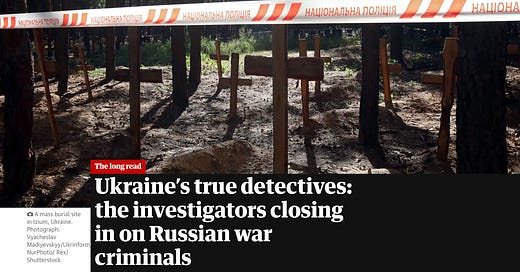Ukraine’s true detectives: The investigators closing in on Russian war criminals
My new story in The Guardian.
Fearless reporting, a behind-the-curtains look at how journalism is made — and an unabashed point of view. Welcome to Chills.
On 8 March, two weeks into the war in Ukraine, Yanina Chmunevich stood in her grassy garden in Bobryk, 35 miles north-east of Kyiv, smoking a cigarette. As it burned to the filter, she counted 87 Russian heavy armoured vehicles going by, including earth-moving equipment, trucks, armoured personnel carriers and cars with long-barrelled guns attached. The next day, she watched the Russians bring in rocket launchers.
Three months later, Chmunevich, 39, who had worked at a petrol station before the war, was steadily recounting the details of the occupation of Bobryk as she sat on a sun porch in a plaid shirt and pink socks. A Ukrainian human rights investigator, Maryna Slobodianiuk, listened intently as she spoke. Slobodianiuk, 40, is a slight woman with a pouf of rust-coloured hair and a voice so quiet that you have to lean in close to hear her properly. But her mild manner is deceptive: as the head of investigations at Ukrainian nonprofit Truth Hounds, researching war crimes and crimes against humanity, she has been to the frontlines in Donetsk, Mykolaiv and Kharkiv, enduring constant bombardment, to record the stories of traumatised survivors. ...
That’s the lede of my new long-form story out today in The Guardian newspaper. I’ve been writing since the summer about my work in Ukraine, and this is the big article I went there to report.
A lot of stories within it were cut for space (it’s running in print too, hence sticking to a word count), as was some of the color I loved writing. But I’ve learned over the years to not get too attached to my words and to trust when I have an excellent editor. And I did have such an editor on this. (We’d previously worked together on my story about the rape of nearly 50 little girls in Congo.)
In this new article, which looks at how you build investigations that, hopefully, lead to convictions of Russians for tens of thousands (and counting) war crimes, I talk about a found cache of Russian documents I’ve been working with. It’s been fascinating to learn how sophisticated investigators like Bellingcat and the Center for Information Resilience are able to triangulate satellite images, scribblings on found documents, social media, CCTV footage and more to nail down what soldiers were where, when, and doing what. The documents are so absurdly revealing that I had the head of war crimes for Ukraine laughing in gratitude to the Russians for their carelessness.
Much of what I was given is evidence that the Russian army was poorly briefed and ill-prepared for the invasion.
One of the points I emphasize is that Ukrainian investigators are focused on building a case for genocide — what that entails, how they’re going about it, etc. Rape is part of it. So is the destruction of historical and cultural artefacts.
There are things that didn’t make it into the final cut, such as the fact that I was also given found documents of call signals — codes for operations communicated from Russians to Russians. The Ukrainian military asked that I not publish them, and I have not. My goal, as with all of my reporting, is to not damage an ongoing investigation. But, again, it shows the ineptitude of this supposedly mighty army.
What I found in my reporting is that there is an unprecedented glut of investigators in Ukraine, which is both helping and hurting the building of war crimes cases. One tidbit cut from the piece is that I followed a trail to a small village outside of Kyiv where a “torture house” was said to have existed. One man I interviewed told me that I was the 15th journalist to speak to him. Fifteenth.
The story, I hope, will give you insight into how we, as journalists, go about reporting on war crimes, and how a global network of accountability is attempting to coordinate the investigation of atrocities on a scale so huge, it appears insurmountable.
As you’ll read, there are some pretty incredible people working nonstop — as missiles shatter their cities and kill their loved ones — to ensure that, one day, there will be justice.
I need your help to keep doing the kind of unique journalism that is Chills. You can help this newsletter expand its content by subscribing. I tell complicated stories from dangerous places — and I do my best to do so ethically.
Chills is self-funded, without ads. If you want to be a part of this effort, of revealing how difficult reporting is made — of sending me to places like Ukraine to report for you — I hope you will consider subscribing for $50/year or $7/month.





First thing I noticed was the British spelling of certain words. Then I was in Ukraine with you, witnessing the Ukrainians trusting you with their stories and the documents they had to bring the perpetrators to justice. That you were given attendance books, maps and battle plans is just crazy. When you went to Babyn Yar, I was there with you too. Having been to the gas chambers and ovens of German concentration camps, there really aren't words to describe how I felt.
It is hard to realize that this is the most documented war - the Germans were so proud of what they were doing, they filmed everything and kept meticulous records. Hopefully, more of the evil monsters terrorizing these innocent people will face justice than the Nazis did. I comment the groups like the Truth Hounds, not waiting until the war is over to investigate. And I commend you - you have guts, grit and immense talent.
Hoang van canh